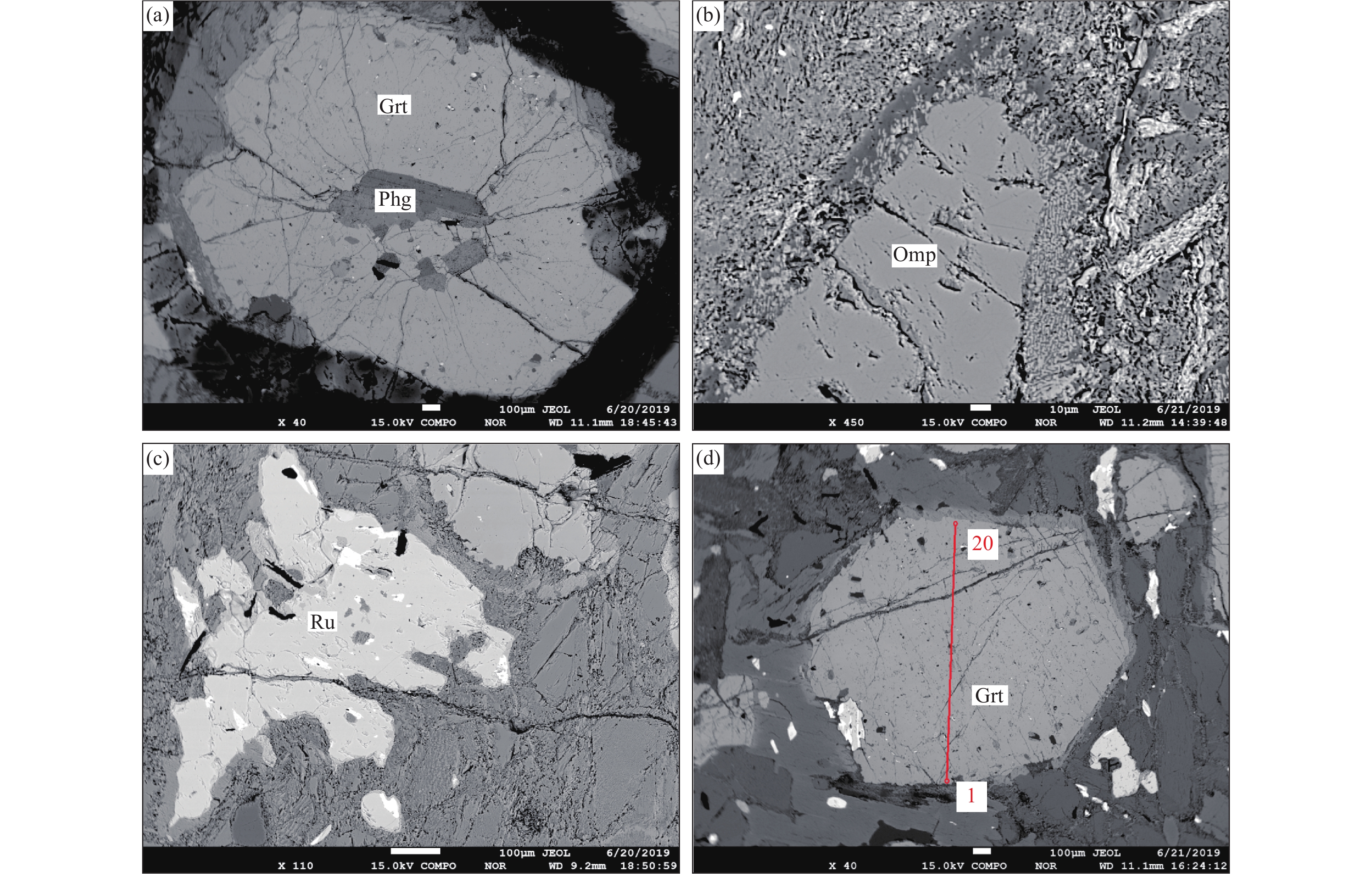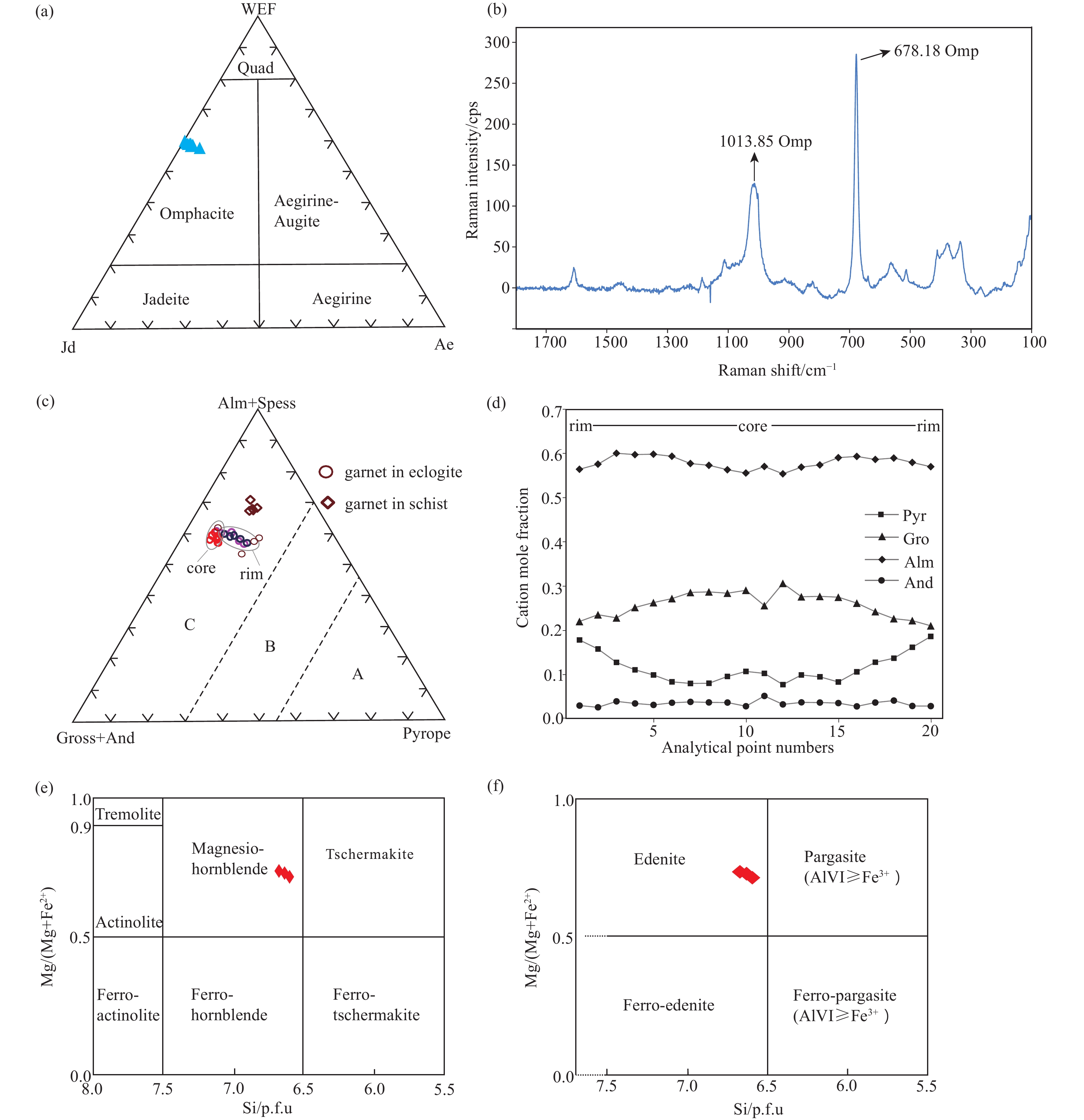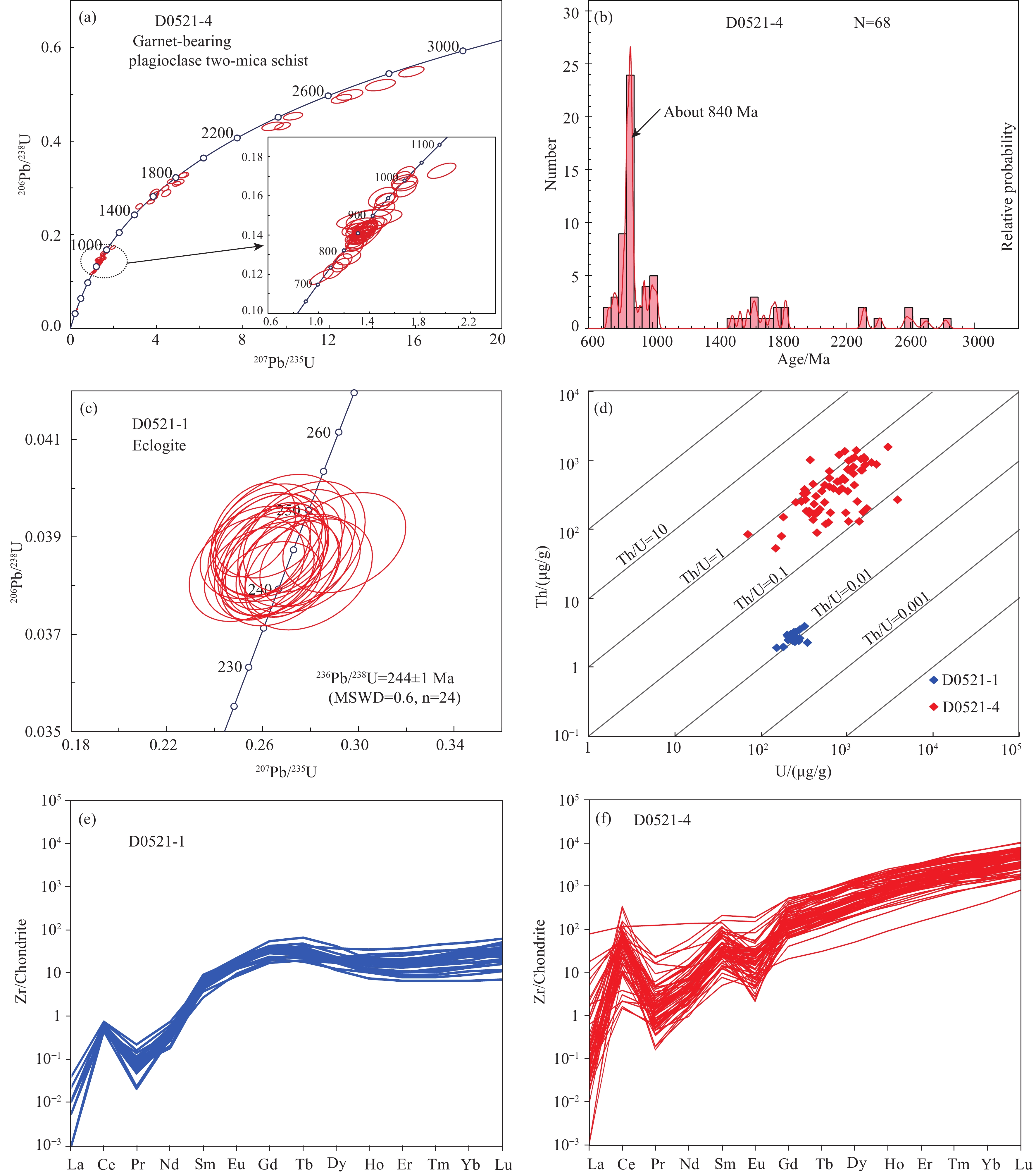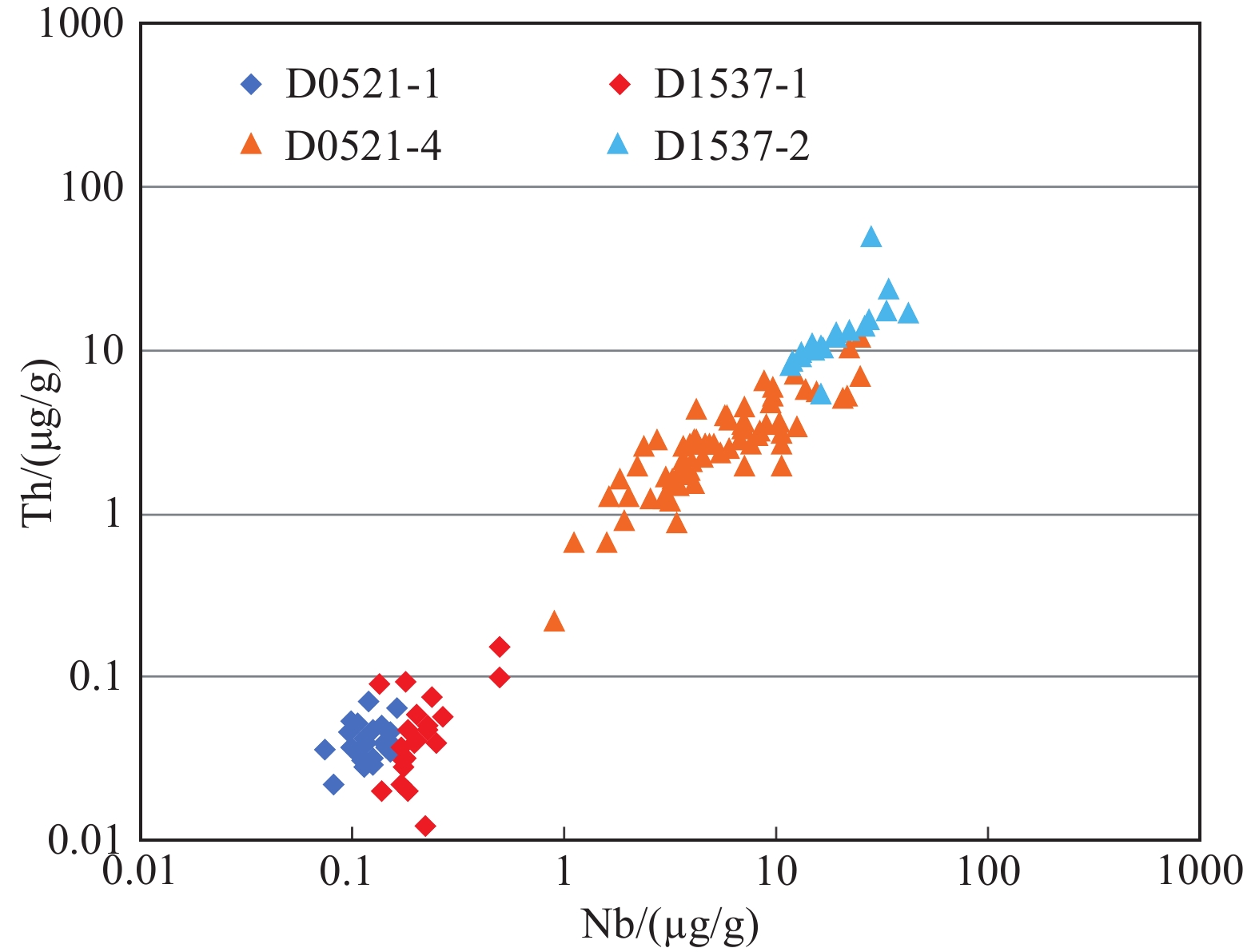| Citation: | Yuan Tang, Ya-dong Qin, Xiao-dong Gong, Yao-yao Duan, Gang Chen, Hong-you Yao, Jun-xiong Liao, Shi-yong Liao, Dong-bing Wang, Bao-di Wang, 2020. Discovery of eclogites in Jinsha River suture zone, Gonjo County, eastern Tibet and its restriction on Paleo-Tethyan evolution, China Geology, 3, 83-103. doi: 10.31035/cg2020003 |
Discovery of eclogites in Jinsha River suture zone, Gonjo County, eastern Tibet and its restriction on Paleo-Tethyan evolution
-
Abstract
As the important component of the eastern Tethys tectonic region, the Jinsha River-Ailao Mountain suture zone is often considered to be an ophiolitic mélange belt. However, the P-T-t path and chronological framework of the metamorphic evolution in the collisional orogenetic process of this zone are still poorly understood owing to the lack of metamorphism research of symbolic high-pressure rocks. During a regional geological survey on a scale of 1∶50000 in Gonjo County, Tibet Autonomous Region involved in this paper, (retrograde) eclogites lenses of different scales were found in Jinsha River suture zone, eastern Tibet for the first time. The (retrograde) eclogites can be divided into garnet-albite-chlorite-actinolite schists and eclogites according to retrograde degrees. The mainly mineral components of eclogites include garnet (45%–50%), clinopyroxene (about 25%), and hornblende (5%–10%) primarily, and biotite, quartz, rutile, and muscovite secondarily. According to the data of electron probe micro analysis (EPMA), clinopyroxenes feature high content of Na2O (5.6%–6%) and corresponding jadeite (Jd) molecules of 37%–44%, and they fall within the omphacite region in Quad-Jd-Ae diagram. The temperature and pressure of the metamorphism at peak are P≈2.2–2.34 GPa and T≈622–688 °C respectively as measured with geobarometry Grt-Omp-Phe and geothermometer Grt-Omp. This will provide a new reference for the understanding of Paleo-Tethyan evolution. In this paper, two samples of eclogites were chosen for LA-ICP-MS zircon U-Pb dating and their 206Pb/238U ages obtained are 240 ± 3 Ma and 244 ± 1 Ma respectively. Furthermore, the zircons feature extremely low Th/U ratio (<0.01), extremely low content of Nb, Ta, and HREE, and invisible negative Eu anomaly. Therefore, the genesis of the zircons shall be eclogites-facies metamorphism, indicating that the 240–245 Ma determined in this paper shall be the age of eclogites-facies metamorphism and may represent the westward subduction-collision epoch of Paleo-Tethys Ocean located between Zhongza Block and Qamdo Block.
-
Keywords:
- Eclogite /
- Omphacite /
- Jinsha River suture zone /
- Geological survey engineering /
- Qinghai-Tibet plateau /
- Eastern Tibet /
- China
-

-
References
[1] Carswell DA, Harley SI. 1990. Mineral barometry and thermometry. In: Carswell DA (ed.). Eclogite facies rocks. Blackie, Glasgow, 83–110. [2] Chen SY, Yang JS, Li Y, Xu XZ. 2009. Ultramafic blocks in the Sumdo Region, Lhasa Block, Eastern Tibet Plateau: An ophiolite unit. Journal of Earth Science, 20, 332–347. doi: 10.1007/s12583-009-0028-x [3] Chung SL, Lee TY, Lo CH, Wang PL, Chen CY, Yem NT, Hoa TT, Wu GY. 1997. Intraplate extension prior to continental extrusion along the Ailao Shan-Red River shear zone. Geology, 25, 311–314. doi: 10.1130/0091-7613(1997)025<0311:IEPTCE>2.3.CO;2 [4] Coleman RG, Lee DE, Beatty LB, Brannock WW. 1965. Eclogites and eclogites: Their differences and similarities. Geological Society of America Bulletin, 76, 483–580. doi: 10.1130/0016-7606(1965)76[483:EAETDA]2.0.CO;2 [5] Corrie SL, Kohn MJ, Vervoort JD. 2010. Young eclogite from the Greater Himalayan Sequence, Arun Valley, eastern Nepal: P-T-t path and tectonic implications. Earth and Planetary Science Letters, 289(3−4), 406–416. doi: 10.1016/j.jpgl.2009.11.029 [6] Dilek Y, Furnes H. 2011. Ophiolite genesis and global tectonics: geochemical and tectonic fingerprinting of ancient oceanic lithosphere. Geological Society of America Bulletin, 123, 387–411. doi: 10.1130/B30446.1 [7] Dilek Y, Furnes H. 2014. Ophiolites and their origins. Elements, 10, 93–100. doi: 10.2113/gselements.10.2.93 [8] Dong YS, Xie YW, Li C, Sha SL. 2007. Discovery of the retrometamorphic eclogite in the Baxoi area, eastern Tibet, China. Geological Bulletin of China, 26(8), 1018–1020 (in Chinese with English abstract). [9] Ellis DJ, Green DH. 1979. An experimental study of the effect of Caupon garnet-clinopyroxene Fe-Mg exchange equilibria. Contributions to Mineralogy and Petrology, 71(1), 13–22. doi: 10.1007/BF00371878 [10] Eskola P. 1920. The mineral facies of rocks. Norsk. Geologisk, Tidsskrift, 8, 1–118. [11] Feng QL, Ye M, Zhang ZJ. 1997. Early carboniferous radiolarians from western Yunnan. Acta Micropalaeontologica Sinica, 14, 79–92 (in Chinese with English abstract). [12] Hu ZC, Zhang W, Liu YS, Gao S, Li M, Zong KQ, Chen HH, Hu SH. 2015. “Wave” signal smoothing and mercury removing device for laser ablation quadrupole and multiple collector ICP-MS analysis: application to lead isotope analysis. Analytical Chemistry, 87, 1152–1157. doi: 10.1021/ac503749k [13] Jian P, Liu DY, Sun XM. 2008. SHRIMP dating of the Permo-Carboniferous Jinshajiang ophiolite, southwestern China: Geochronological constraints for the evolution of Paleo-Tethys. Journal of Asian Earth Sciences, 32, 371–384. doi: 10.1016/j.jseaes.2007.11.006 [14] Jian P, Wang XF, He LQ, Wang CS. 1998. U-Pb zircon dating of the Shuanggou ophiolite from Xinping County, Yunnan Province. Acta Petrologica Sinica, 14(2), 207–211 (in Chinese with English abstract). [15] Jian P, Liu D, Kroner A, Zhang Q, Wang YZ, Sun XM, Zhang W. 2009. Devonian to Permian plate tectonic cycle of the Paleo-Tethys Orogen in southwest China (II): Insights from zircon ages of ophiolites, arc/back-arc assemblages and within-plate igneous rocks and generation of the Emeishan CFB province. Lithos, 113, 767–784. doi: 10.1016/j.lithos.2009.04.006 [16] Krogh EJ. 1988. The garnet-clinopyroxene Fe-Mg geothermometer: A reinterpretation of existing experimental data. Contributions to Mineralogy and Petrology, 99(1), 44–48. doi: 10.1007/BF00399364 [17] Leake BE, Woolley AR, Arps CES, Nirch WD, Gillbet MC, Grice JD, Guo YZ. 1997. Nomenclature of amphiboles: Report of the subcommittee on amphiboles of the international mineralogical association, commission on new minerals and mineral names. American Mineralogist, 61, 295–321. [18] Li C, Zhai QG, Dong YS, Huang XP. 2006. Discovery of eclogite and its geological significance in Qiangtang area, central Tibet. Chinese Science Bulletin, 51(9), 1095–1100 (in Chinese with English abstract). doi: 10.1007/s11434-006-1095-3 [19] Li XZ, Liu WJ, Wang YZ, Zhu QW. 1999. The tectonic evolution and metallogenesis in the Tehys of the Nujiang-Langcangjiang-Jinshajiang area, southwestern china. Beijing, Geological Publishing House, 45–73, 122–132 (in Chinese with English abstract). [20] Li HQ, Cai ZH, Chen SY, Tang ZM, Yang M. 2008. The Indosinian orogenesis occurred in Lhasa terrain and the evidence from muscovite 40Ar/39Ar geochronology. Acta Petrologica Sinica, 24, 1595–1604 (in Chinese with English abstract). [21] Li J, Sun ZB, Xu GX, Zhou K, Huang L, Tian SM, Ze ng, W T, Chen GY, Liu GC. 2015. Firstly discovered garnet-amphibolite from Mengku area, Shuangjiang County, Western Yunnan Province, China. Acta Mineralogica Sinica, 35(4), 421–424 (in Chinese with English abstract). [22] Liu Y, Li RS, Ji WH, Pan SJ, Chen FN, Zhang HD. 2014. The pairing relationship between ophiolite and arc volcanic rocks along western Jinsha River suture zone and its geological significance: Evidence from geochemistry and LA-ICP-MS zircon U-Pb dating. Geological Bulletin of China, 33(7), 1076–1088. [23] Liu ZQ, Li XZ, Ye QT, Luo JN, Shen GF, Yang YQ. 1993. Division of tectono-magmatic zones and the distribution of deposits in the Sanjiang area. Beijing, Geological Publishing House, 6–89 (in Chinese with English abstract). [24] Liu JL, Tran MD, Tang Y, Nguyen QL, Tran TH, Wu WB, Chen JF, Zhang ZC, Zhao ZD. 2012. Permo-Triassic granitoids in the northern part of the Truong Son belt, NW Vietnam: Geochronology, geochemistry and tectonic implications. Gondwana Research, 22(2), 628–644. doi: 10.1016/j.gr.2011.10.011 [25] Liu YS, Gao S, Hu ZC, Gao CG, Zong KQ, Wang DB. 2010. Continental and oceanic crust recycling-induced melt-peridotite interactions in the Trans-North China Orogen: U-Pb dating, Hf isotopes and trace elements in zircons of mantle xenoliths. Journal of Petrology, 51, 537–571. doi: 10.1093/petrology/egp082 [26] Liu YS, Hu ZC, Gao S, Guünther D, Xu J, Gao CG, Chen HH. 2008. In situ analysis of major and trace elements of anhydrous minerals by LA-ICP-MS without applying an internal standard. Chemical Geology, 257, 34–43. doi: 10.1016/j.chemgeo.2008.08.004 [27] Ludwig KR. 2003. ISOPLOT 3.00: A Geochronological Toolkit for Microsoft Excel. Berkeley Geochronology Center, California, Berkeley, 39. [28] Metcalfe I. 2006. Palaeozoic and Mesozoic tectonic evolution and palaeogeography of East Asian crustal fragments: The Korean Peninsula in context. Gondwana Research, 9, 24–46. doi: 10.1016/j.gr.2005.04.002 [29] Mo XX, Lu FX, Shen SY. 1993. Sanjiang tethys volcanism and related mineralization. Beijing, Geological Publishing House, 65–77 (in Chinese with English abstract). [30] Moller C. 1998. Decompressed eclogites in the Sveconorwegian (-Crenvillian) Orohen of SW Sweden: petrology and tectonic implications. Journal of Metamorphic Geology, 16(5), 641–656. doi: 10.1111/j.1525-1314.1998.00160.x [31] Morimoto N, Fabries J, Ferguson AK, Ginzburg IV, Ross M, Seifert FA, Zussman J. 1988. Nomenclature of pyroxenes. American Mineralogist, 73(9−10), 1123–1133. [32] Nakano N, Osanai Y, Minh NT, Miyamoto T, Hayasaka Y, Owada M. 2008. Discovery of high-pressure granulite-facies metamorphism in Northern Vietnam: Constraints on the Permo-Triassic Indo-Chinese continental collision tectonics. Comptes Rendus Geoscience, 340(2/3), 127–138. [33] Nakano N, Osanai Y, Sajeev K, Hayasaka Y, Miyamoto T, Minh NT, Owada M, Windley B. 2010. Triassic eclogite from northern Vietnam: inferences and geological significance. Journal of Metamorphic Geology, 28, 59–76. doi: 10.1111/j.1525-1314.2009.00853.x [34] Pan GT, Xu Q, Hou ZQ, Wang LQ, Du DX, Mo XX, Li DM, Wang MJ, Li XZ, Jiang XS. 2003. Archipelagic orogenesis, metallogenic systems and assessment of the mineral resources along the Nujiang-Langcangjiang-Jinshajiang area in southwestern China. Beijing, Geological Publishing House, 11–79 (in Chinese with English abstract). [35] Powell R. 1985. Regression diagnostics and robust regression in geothermometer /geobarometer calibration: The garnet-clinopyroxene geothermometer revisited. Journal of Metamorphic Geology, 3(3), 231–243. doi: 10.1111/j.1525-1314.1985.tb00319.x [36] Ravna EK, Terry MP. 2001. Geothermobarometry of phengite kyanite-quartz/coesite eclogites. Eleventh annual V. M. Goldschmidt conference, abstract, 3145. [37] Ravna EK. 2000. The garnet-clinopyrox ene Fe2+ -Mg geothermometer: an updated calibration. Journal of Metamorphic Geology, 18, 211–219. doi: 10.1046/j.1525-1314.2000.00247.x [38] Sun SS, McDonough WF. 1989. Chemical and isotopic systematics of oceanic basalts: Implications for mantle composition and processes. London, UK, Geological Society, 313–345. [39] Sun XM, Jian P. 2004. The wilson cycle of the Jinshajiang paleo-Tethys Ocean, in western Yunnan and western Sichuan Province. Geological Review, 50, 343–350 (in Chinese with English abstract). [40] Wang DB, Wang LQ, Yin FG, Sun ZM, Wang BD, Zhang WP. 2012. Timing and nature of the Jinshajiang Paleo-Tethys: Constraints from zircon U-Pb age and Hf isotope of the Dongzhulin layered gabbro from Jinshajiang ophiolite belt, northwestern Yunnan. Acta Petrologica Sinica, 28(5), 1542–1550 (in Chinese with English abstract). [41] Wang HN, Liu FL, Li J, Sun ZB, Ji L, Tian Z, Liu L, Santosh M. 2018. Petrology, geochemistry and P-T-t path of lawsonite-bearing retrograded eclogites in the Changning-Menglian orogenic belt, southeast Tibetan Plateau. Journal of Metamorphic Geology, 37(4), 439–478. [42] Wang LQ, Pan GT, Li DM, Xu Q, Lin SL. 1999. The spatial-temporal framework and geological evolution of the Jinshajiang arc-basin systems. Act Geological Sinica, 73, 206–218 (in Chinese with English abstract). [43] Wang XF, Metcalfe I, Jian P, He LQ, Wang CS. 2000. The Jinshajiang-Ailaoshan suture zone, China tectonostratigraphy, age and evolution. Journal of Asian Earth Sciences, 18, 675–690. doi: 10.1016/S1367-9120(00)00039-0 [44] Waters DJ, Martin HN. 1993. Geobarometry of phengite-bearing eclogite. Terra Abstract, 5, 410–411. [45] Wu Y, Li C, Xu M, Xie C, Wang M. 2017. Zircon U-Pb age, geochemical data: Constraints on the origin and tectonic evolution of the metamafic rocks from Longmuco-Shuanghu-Lancang suture zone, Tibet. Journal of Earth Science, 28(3), 422–432. doi: 10.1007/s12583-017-0730-z [46] Wu YB, Zheng YF. 2004. Genesis of zircon and its constranints on interpretation of U-Pb age. Chinese Science Bulletin, 49, 1554–1569. doi: 10.1007/BF03184122 [47] Xu XZ, Yang JS, Li TF, Chen SY, Ren YF, Li ZL, Shi YR. 2007. SHRIMP U-Pb ages and inclusions of zircons from the Sumdo eclogite in the Lhasa block, Tibet, China. Geological Bulletin of China, 26(10), 1340–1355. [48] Xu ZQ, Dilek Y, Cao H, Yang JS, Robinson P, Ma CQ, Li HQ, Jolivet M, Roger F, Chen XJ. 2015. Paleo-Tethyan evolution of Tibet as recorded in the East Cimmerides and West Cathaysides. Journal of Asian Earth Sciences, 105, 320–337. doi: 10.1016/j.jseaes.2015.01.021 [49] Yang JS, Xu ZQ, Li TF, Li HQ, Li ZL, Ren YF, Xu XZ, Chen SY. 2007. Oceanic subduction - type eclogite in the Lhasa block, Tibet, China: Remains of the Paleo-Tethys ocean basin? Geological Bulletin of China, 26(10), 1277–1287. [50] Yang JS, Xu ZQ, Geng QR, Li ZL, Xu XZ, Li TF, Ren YF, Li HQ, Cai ZH, Liang FH, Chen SN. 2006. A possible new HP/UHP? metamorphic belt in China: discovery of eclogite in the Lhasa terrane, Tibet Act Geological Sinica, 8(12), 1787–1792 (in Chinese with English abstract). [51] Yumul GP, Zhou MF, Wang CY. 2008. Geology and geochemistry of the Shuanggou ophiolite (Ailao Shan ophiolitic belt), Yunnan Province, SW China: Evidence for a slow-spreading oceanic basin origin. Journal of Asian Earth Sciences, 32, 385–395. doi: 10.1016/j.jseaes.2007.11.007 [52] Zhai QG, Jahn BM, Su L, Ernst RE, Wang KL, Zhang RY, Wang J, Tang S. 2013. SHRIMP zircon U-Pb geochronology, geochemistry and Sr-Nd-Hf isotopic compositions of a mafic dyke swarm in the Qiangtang terrane, northern Tibet and geodynamic implications. Lithos, 174, 28–43. doi: 10.1016/j.lithos.2012.10.018 [53] Zhai QG, Zhang RY, Jahn BM, Li, C, Song SG, Wang J. 2011. Triassic eclogites from central Qiangtang, northern Tibet, China: Petrology, geochronology and metamorphic P-T path. Lithos, 125, 173–189. doi: 10.1016/j.lithos.2011.02.004 [54] Zhang Q, Zhou DJ, Zhao DS, Peng XJ, Luo WL, Liu XP. 1996. Wilson cycle of the paleo-Tethys orogenic belt in western Yunnan: record of magmatism and discussion on mantle processes. Acta Petrologica Sinica, 12, 17–28 (in Chinese with English abstract). [55] Zhang RY, Lo CH, Chung SL, Grove M., Omori S, Iizuka Y, Liou JG, Tran VT. 2013. Origin and tectonic implication of ophiolite and eclogite in the Song Ma Suture Zone between the South China and Indochina Blocks. Journal of Metamorphic Geology, 31, 49–62. doi: 10.1111/jmg.12012 [56] Zhao G, Cawood PA, Wilde SA, et al. 2001. High-pressure granulites (retrograded eclogites) from the Hengshan Complex, north China craton: Petrology and tectonic implications. Journal of Petrology, 42(6), 1141–1170. doi: 10.1093/petrology/42.6.1141 [57] Zhong DL. 1998. The Paleotethys orogenic belt in west of Sichuan and Yunnan. Beijing, Science Publishing House, 1–230 (in Chinese). [58] Zhu JJ, Hu RZ, Bi XW, Zhong H, Chen H. 2011. Zircon U-Pb ages, Hf-O isotopes and whole-rock Sr-Nd-Pb isotopic geochemistry of granitoids in the Jinshajiang suture zone, SW China: Constraints on petrogenesis and tectonic evolution of the Paleo-Tethys Ocean. Lithos, 126, 248–264. doi: 10.1016/j.lithos.2011.07.003 [59] Zong KQ, Klemd R, Yuan Y, He ZY, Guo JL, Shi XL, Liu YS, Hu ZC, Zhang ZM. 2017. The assembly of Rodinia: The correlation of early Neoproterozoic (ca. 900 Ma) high-grade metamorphism and continental arc formation in the southern Beishan Orogen, southern Central Asian Orogenic Belt (CAOB). Precambrian Research, 290, 32–48. -
Access History

-
Figure 1.
Simplified tectonic map with age data, showing the Paleo-Tethyan system in Tibet and adjacent area (after Xu ZQ et al., 2015).
-
Figure 2.
a–Geotectonic schematic map of Jinsha River suture zone (after Li XZ et al., 1999); b–generalized geological map of Jinsha River suture zone, Gonjo, Eastern Tibet (its location is shown in Fig. 2a).
-
Figure 3.
Field occurrence characteristics of retrograde eclogites. a–d–retrograde eclogites occurring in the shape of lens; e–chlorite retrograded from garnet; f–white rim structure (yellow arrow) developed around a part of garnets; g–eclogites with low retrograde metamorphism.
-
Figure 4.
Microscopic characteristics of garnet-albite-chlorite actinolite (cross-polarized light). a–residual garnets and small chlorite + albite + actinolite compose symplectites, and retrograde reaction rim; b–residual pyroxene. Grt–garnet, Chl–chlorite, Ab–albite, Act–actinolite, Cpx–clinopyroxene.
-
Figure 5.
Microscopic characteristics of eclogites (a, c–cross-polarized light; b, d–plane-polarized light); cracks visible and fine mineral inclusions developing in garnet crystals; omphacite hypautomorphic columnar in shape and sub-amphibolized, with rutile inclusions visible inside garnet grains. Grt–garnet, Omp–omphacite, Amp–hornblende, Bt–biotite, Qz–quartz, Ms–muscovite, Ru–rutile, red arrows indicates blue-green hornblendes growing around the garnet.
-
Figure 6.
SEM images of eclogites. a–garnet with radial cracks and phengite occurring among cracks in the fine foliaceous shape; b–worm-like fine grains generating omphacite rim owing to decompression and decomposition; c–rutile in xenomorphic granular shape; d–diagram of garnet components obtained by EPMA. Grt–garnet, Omp–omphacite, Phg–phengite, Ru–rutile.
-
Figure 7.
a–Quad-Jd-Ae compositional diagram of clinopyroxene, showing all testing points falling within the omphacite region; b–characteristics of Raman spectra of clinopyroxene in the eclogites, having the characteristic spectral peaks of omphacite; c–end-member composition diagramof garnet, showing testing points falling within the area of class-C garnet; d–garnet composition diagram; e–f–hornblende composition diagram, showing testing pointsfalling within subclasses magnesiohornblende and achromaite (a, after Morimoto N et al., 1988; c, after Coleman RG et al., 1965; e–f, after Leake BE et al., 1997).
-
Figure 8.
Partial CL images of zircons in eclogites and their hosting rocks.
-
Figure 9.
a–U-Pb age of zircons in sample D0521-4; b–cumulative gaussian and histogram plots of zircons in sample D0521-4; c–U-Pb concordant diagrams of zircons in sample D0521-1; d–contents of Th and U and Th/U ratios of zircons in samples D0521-4 and D0521-1; e–f–REE chondrite normalized diagram of in situ single zircon in samples D0521-4 and D0521-1. Chondrite values are from Sun SS and McDonough WF, 1989.
-
Figure 10.
a–b–U-Pb age concordia diagram of zircons in samples D01537-1 and D1537-2; c–content of Th and U and Th/U ratio of zircon in samples D01537-1 and D1537-2; d–chondrite-normalized REE patterns for in situ single zircon from sample D0521-4 and D0521-1. Chondrite values are from Sun SS and McDonough WF, 1989.
-
Figure 11.
Content of Ta and Nb of zircons in the samples for LA-ICP-MS zircon U-Pb dating.



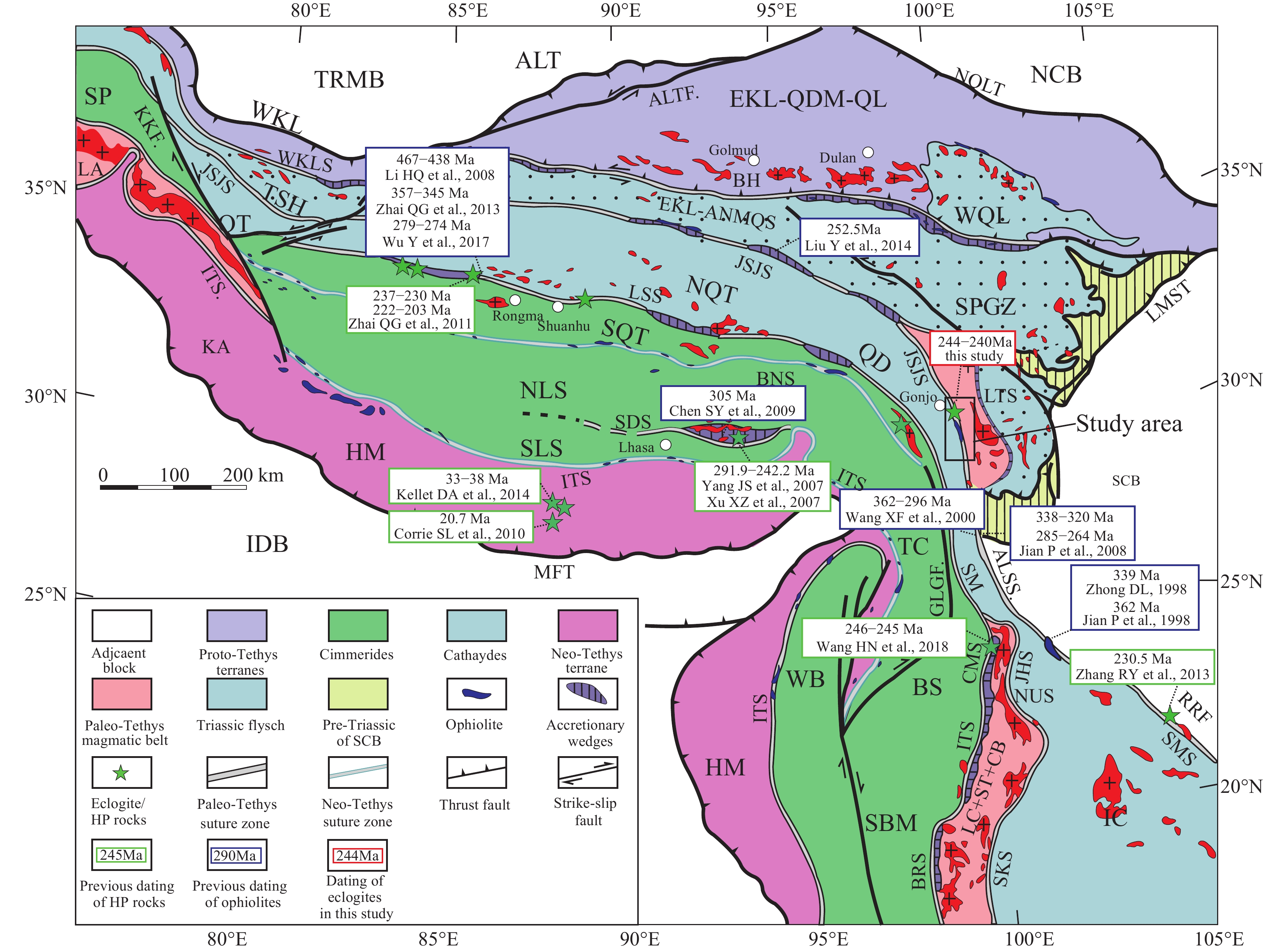

 DownLoad:
DownLoad:




